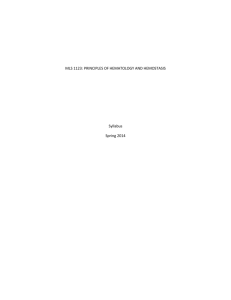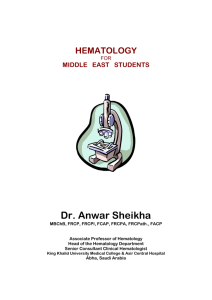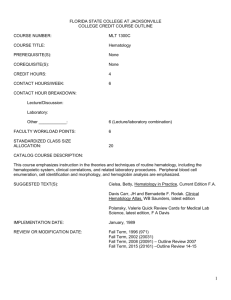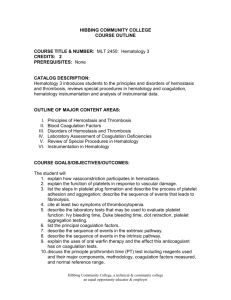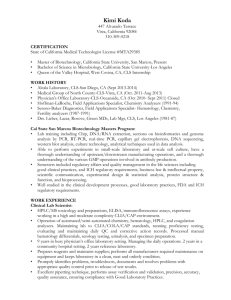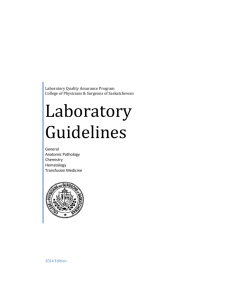ML225 - SharePoint - Erie Community College
advertisement
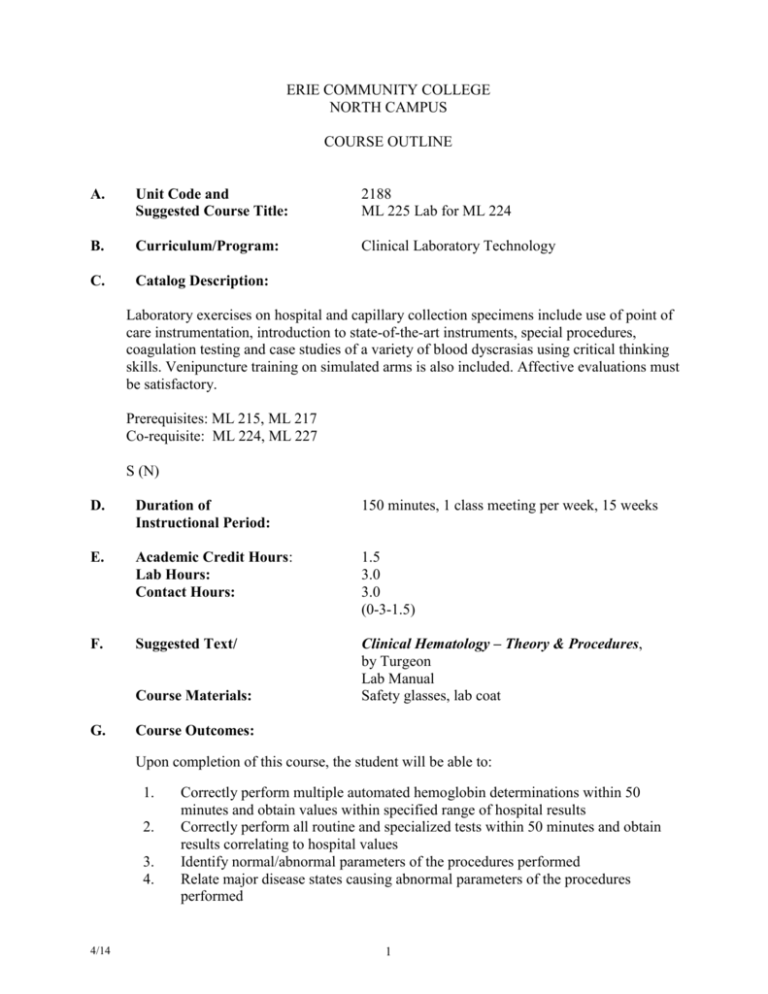
ERIE COMMUNITY COLLEGE NORTH CAMPUS COURSE OUTLINE A. Unit Code and Suggested Course Title: 2188 ML 225 Lab for ML 224 B. Curriculum/Program: Clinical Laboratory Technology C. Catalog Description: Laboratory exercises on hospital and capillary collection specimens include use of point of care instrumentation, introduction to state-of-the-art instruments, special procedures, coagulation testing and case studies of a variety of blood dyscrasias using critical thinking skills. Venipuncture training on simulated arms is also included. Affective evaluations must be satisfactory. Prerequisites: ML 215, ML 217 Co-requisite: ML 224, ML 227 S (N) D. Duration of Instructional Period: 150 minutes, 1 class meeting per week, 15 weeks E. Academic Credit Hours: Lab Hours: Contact Hours: 1.5 3.0 3.0 (0-3-1.5) F. Suggested Text/ Clinical Hematology – Theory & Procedures, by Turgeon Lab Manual Safety glasses, lab coat Course Materials: G. Course Outcomes: Upon completion of this course, the student will be able to: 1. 2. 3. 4. 4/14 Correctly perform multiple automated hemoglobin determinations within 50 minutes and obtain values within specified range of hospital results Correctly perform all routine and specialized tests within 50 minutes and obtain results correlating to hospital values Identify normal/abnormal parameters of the procedures performed Relate major disease states causing abnormal parameters of the procedures performed 1 5. 6. 7. 8. 9. 10. 11. 12. 13. 14. 15. G. Use appropriate QC for lab tests as indicated Review usage of the blood smear as a check of RBC indices, white blood cell and platelet count values Complete case study portfolios on selected dyscrasias of the erythrocytic, leukocytic and coagulation systems Identify follow-up/additional tests required for confirmation of diagnosis in the anemias, leukemias, and coagulation systems Perform venipuncture on simulator arms safely and properly within 10 minutes Perform micro collection methods safely and properly within 15 minutes Perform PT/INR, APTT on the Fibrometer, CoaguChek, Alere and Thromboscreen instruments and other selected coagulation tests Perform the platelet count, calculate and record using proper format Perform all laboratory tests with maximum accuracy and integrity and report them in a concise manner using appropriate units, proper hospital forms/computer entry and with minimal supervision Log-in all samples into logbook record Strictly follow lab safety rules, privacy requirements on all procedures on and off campus Program Competencies: Upon graduation with an Associates in Applied Science Degree in Clinical Laboratory Technology, the graduate will be able to: a. b. Perform all of the routine tests in a modern clinical laboratory. (1-3, 5, 6, 8-15) Identify direct causes of technical or instrumental problems and make appropriate corrections using present strategies. (1-3, 5, 6, 8-15) c. Collect and prepare human samples for analysis. Store and transport samples using appropriate preservation methods. Specimens may include blood, urine, and other body fluids. (1, 2, 9-12, 14, 15) d. Following prescribed procedures, performs routine analytical tests in chemistry, hematology/hemostasis, immunology, immunohematology, and microbiology. (1-3, 5, 6, 8-15) e. Calculate the results of tests performed if necessary. (1, 2, 6) f. Operate equipment or instruments necessary for routine analytical tests. Recognize instrument malfunction and take appropriate action. (1, 2, 5, 6, 7, 9-15) g. Perform, record, and evaluate quality control procedures required for the tests assayed. (1-3, 5, 6, 8-13) h. Recognize abnormal or unusual test results and follow institutional procedures for reporting critical values. (1-6, 8-13) i. Report results in writing, orally or by computer, conforming to established procedures. (1-3, 5, 7, 10-14) j. Perform and record routine instrument checks and maintenance procedures. (1, 2, 13,14) k. Observe established safety measures. (1-15) l. Maintain the work area in clean, orderly, well-labeled condition. (1-3, 5-15) m. Perform related work as assigned. (1-14) 4/14 2 n. I. Demonstrate behavior consistent with acceptable professional conduct standards, such as appearance, quality of work, quantity of work, human relation skills, leadership skills, written, and verbal communication skills. (1-15) SUNY General Education Ten Knowledge Areas: Not applicable to course offering in Health Science Division. J. ECC Learning Outcomes (LO): 1. 2. 3. 4. 5. K. Communication (1-5, 7-15) Critical Analysis and Reasoning (1-4, 6-8) Information Literacy (1-14) Scientific Reasoning (1-3, 6-13) Quantitative Reasoning (2, 7, 12) Student Learning: K1. Evaluation of Student Learning: Course outcomes may be met by chapter quizzes, homework assignments, hourly examinations containing case studies, Board of Certification simulated final exam that is comprehensive and cumulative and/or a final paper/ research project that will be calculated/ weighed accordingly. The methods of evaluation will be consistent with the level of the course and meet criteria as set forth by the Accreditation Agencies to include cognitive levels I, II and III, as well as affective and psychomotor skills appropriate to the course. Achievements of objectives will be measured by: A. Written examinations, quizzes 50% B. Laboratory exercises 50% 1. Students must report lab test results in a concise and accurate format 2. Case study portfolios for normal, reactive, and malignant states maintained in an indexed lab manual 3. Lab competencies Lab exercise-Unknown – Depending upon the procedure, each student receives from 1-3 unknown blood samples/week. Grading is based on accuracy obtained as compared to hospital reported value given constraints of instrument variation and manual vs. automated methodologies. Concise, accurate and neat reporting following established procedures is essential. Completion of worksheets and study questions in lab manual. Competencies-Checklist evaluation(s) – varies as to the testing procedure, class size and time constraints. Completion of case study portfolios with indexed lab manual. Values and attitudes are recognized as important components of the Medical Office Practice/Medical Office Assisting profession because those traits, as well as, knowledge and skills, influence performance. The affective evaluation for this course includes the 4/14 3 following areas: time management, workload management, facilities management, and professionalism. K2. Assessment of Student Learning: Student knowledge and competency in this course will be evaluated through the administration of questions that typify those commonly asked on BOC certification exam formats. These will be included on assessments based on expected course outcomes. L. Library Resources: M. I. Anderson’s Atlas of Hematology Hoffbrand, Victor Essential Hematology Harmening, Denise Clinical Hematology and Fundamentals of Hemostasis Carr, Jacqueline Clinical Hematology Atlas Gulati, Gene Blood Cells Ciesla, Betty Hematology in Practice Lichtman, William Hematology Turgeon, Mary Louise Clinical Hematology Lanzkowsky, Philip Manual of Pediatric Hematology and Oncology McKenzie, Shirlyn Clinical Laboratory Hematology Rodak, Bernadette Hematology Clinical Principles and Applications Clinical Laboratory Science (periodical) Clinics in Laboratory Medicine (periodical) CMA Today (periodical) Laboratory Medicine (periodical) Medical Laboratory Observer ( periodical and journal) New Zealand Journal of Medical Laboratory Science (journal) Mcpherson, Richard A. – Henry’s Clinical Diagnosis and Management by Laboratory Methods Topical Outline: week(s) ALLIED HEALTH FORMS – PPD; Safety protocol form signature; Normal 1 differential review; Instructor’s briefing and completion of student case study report forms Venipuncture; Case studies: Non-malignant increases : Eosinophilia, Basophilia, Monocytosis, Granulocytic Left, Shift w/Dohle bodies II. III. 4/14 COMPETENCY: Venipuncture review and Competency Non-malignant increases; Case studies continued; Fingerstick – Hgb, Hct 1 ERYTHROCYTES: Reticulocyte Count, Calculate %, Absolute retic. count, Corrected retic. count, and RPI, Evaluate BM response 1 4 IV. CASE STUDIES: Red cell Morphology and Inclusions; Case Studies Slides# 160, 168, 1 32, 013, 198, 1 #321 Demo: Slide #1606 Malaria, Babesia Demo: Slide #101-104 Cord Blood V. CASE STUDIES - THE ANEMIAS: MICROCYTIC ANEMIAS – Case Studies Slides: #85, 8, 3.8, Thal Trait; MACROCYTIC ANEMIAS - Slides: MACPA, #23, #307; Demo: Slide #28 Cold Agglutinin, Demo: Slide #302 Pancytopenia VI. CASE STUDIES - THE ANEMIAS – HEMOLOBINOPATHIES: SICKLE CELL DISEASE: Solubility testing/Sickledex kit & Hct, Hgb. Competency Electrophoresis samples for review; Review Power Point for RBC Morphology competency; Demo: C/C, S/C, S/D 1 COMPETENCY: Power Point - Red cell Morphology, Inclusions and the Anemia; ESR Review; Start Case Studies – Lymphocyte variants/atypical, reactive 1 LEUKOCYTES - NON-MALIGNANT DISORDERS Case Studies: GRANULOCYTIC: Pelger Huet, Granulocytic Leukemoid response/shift to the left; LYMPHOID: Infectious Mononucleosis, Plasma Cells; Other: Slide #1113 Multiple Myeloma 1 IX. CASE STUDIES - MALIGNANT DISEASES - THE ACUTE LEUKEMIAS: Case Studies – AML Myeloid, *Slides #20, 189, 800, SL120-125, AR18, 276 Case Studies – ALL Lymphoid, * Slides #AW 3-9, 22, 880, 1952 – Pre B-ALL (*number varies with size of class and time constraints) 1 X. THE CHRONIC LEUKEMIAS: Case Studies – CML *Slides *88, 36, 851, PV Case Studies – CLL *Slides #169, 59, 3-7 ; Review for WBC Competency (number varies with size of class and time constraints) 1 XI. COMPETENCY - Power Point: Normal and abnormal white cells, inclusions and diseases – Platelet evaluation thrombocytosis, thrombocytopenia 1 HEMOSTASIS & COAGULATION: 4 VII. VIII. XII. 1. 2. 3. 4. 5. 4/14 Fibrometer – PT & APTT Coagu-Chek and Alere Instruments - fingerstick PT/INR Fingerstick Thrombotic platelet count/make blood smear/stain/plat.estimate D-Dimer – Slide Agglutination. ThromboScreen PT/APTT 5 1 XIII. Continue: Fibrometer, CoaguChek and D-Dimer Add: AlereINR/PT (fingerstick) Rotate through stations XIV. Continue: Coagu-Chek Instrument - fingerstick: PT/INR, fingerstick: Thrombotic platelet count, make and stain the smear, platelet estimate Alere Instrument- fingerstick : PT/INR XV. N. 4/14 Finish up Proposal Prepared by: Date Prepared: Date Last Updated: CLT/MA Faculty April 2014 March 2008 6
